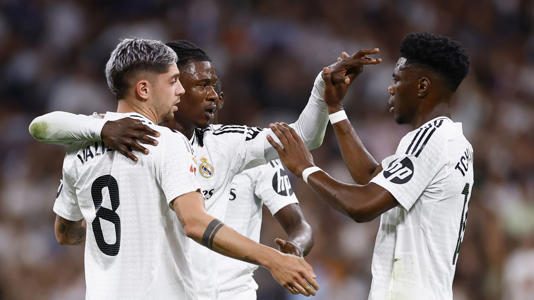At this point, the Managing Madrid crew sounds like a broken record — many of us imploring Ancelotti to end his persistent tactical idea of pressing high in the opposition’s half. Real Madrid have never been a consistently good pressing team. They are a team that can have “moments” and phases within games where they execute an effective press, but rarely — if ever — have they been effective over large stretches of a match or a consistent period of games. If, for whatever reason, Ancelotti feels it is imperative to continue pressing with the players he has available, then different personnel selection and an entirely different schematic make-up would be required to deliver better results. In other words, Ancelotti would have to make big calls on team shape and potentially drop some big names.
Eduardo Camavinga and Aurelien Tchouameni stood out in France for a number of reasons, but the clear highlight was their ability to win the ball back. Camavinga ranks in the 94th percentile for tackles won among other midfielders, while Tchouameni reads plays at an elite level, ranking in the 91st percentile for interceptions. Prior to the Clasico, Tchouameni ranked 1st in the big five leagues for interceptions and was among the top 5 for recoveries in the opposition’s half. To have an effective press, you need elite ball winners, but those ball winners need to be positioned higher up the pitch.
Neither Camavinga nor Tchouameni should act as a lone pivot or defensive midfielder in a pressing scheme. That position is one of the few in a collective press that requires a midfielder to occupy space rather than engage in man-to-man pressing. It’s a role that demands discipline and an understanding of the space behind. Camavinga and Tchouameni thrive in physical duels, not in reading space to clog gaps.
Spanish journalist covering French football, Andres Onrubia Ramos, said of Tchouameni: “At Monaco, Tchouameni was an ‘arriver’ and always played with a pivot behind him, Fofana. Now, as a ‘5’, he defends forward as if he had a player behind him covering his back. He leaves his zone and is caught off guard with the open space.” Unlike Casemiro, who had a sixth sense for positioning and spatial awareness, Tchouameni is eager to leave his pivot spot to win the ball but ends up exposing the space behind him. This has led to multiple poor performances. Compounding this issue is the back four’s inability to maintain shape and move up in unison when the midfield presses.
With Camavinga, it is a similar story. To maximize his ball-winning abilities, he needs to be in direct contact with the opposition. Against Barcelona, Camavinga had a team-high 11 recoveries, 7 of which came in the second half, and over 85% were in Barcelona’s half. He had the highest duel-winning percentage and the most duels in the game despite playing only 77 minutes. Unleashed with more freedom as a hybrid left midfielder/interior tasked with pressing Kounde, the Frenchman thrived. Another example is the Champions League final, where Ancelotti’s key tactical tweak at halftime was moving Camavinga to a high-pressing #8 role and shifting Valverde to the lone pivot.
